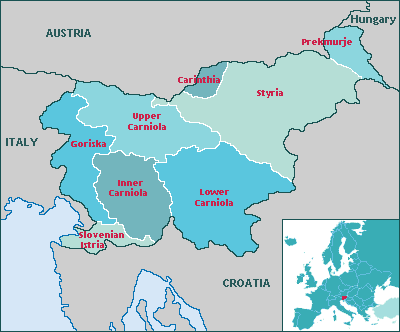Slovenia
First among the states of former Jugoslavia to become independent in 1991, the country shifted peacefully to a market economy and a seamless integration with Western Europe.
In short
Area: 20273 km²
-- Population: about 2 million
-- Density: 99 per km²
-- Government: Parliamentary republic
-- Capital: Ljubljana
-- Language: Slovenian, Italian, Hungarian
-- Religion: Catholic
-- Currency: Euro
-- Telephone code: +386
-- International car plate: SLO
-- Internet suffix: .si
-- Member of: the ONU since 22 May 1992, the EU since 1 May 2004

Administrative division
When Slovenia was part of the Austrian-Hungarian Empire, it was divided into four Habsburg crown lands (Carniola, Carinthia, Styria, and the Littoral); the present regions, which are traditional and have no administrative function, are:
Upper Carniola (Gorenjska), Styria (Štajerska), Prekmurje (Prekmurje), Carinthia (Koroška), Inner Carniola (Notranjska), Lower Carniola (Dolenjska), Goriska (Goriška), Slovenian Istria (Slovenska Istra).
The territory
This small country comprises very different landscapes, from Alpine ski fields surrounded by majestic summits, to the fascinating Bled lake, thick forests and Karst grottos, along the Adriatic sunny, sandy beaches of Istria and celebrated spa facilities and thermal waters, which for centuries attracted visitors from central Europe.
Cities and places of interest
Ljubljana, the capital, is situated on the Sava river, and was since very ancient times an important transit and trade center between the Balkans and central and western Europe; the city features one of the main museums of Balkans, the Ljubljana Museum of National History.
Other important centers are Maribor on the Drava river, the second largest city, Koper and Nova Gorica opposite the Italian Gorizia across the border.
Among the most remarkable sites is the Postojna Caves, the largest and most important grotto system in Europe, with 21 km discovered so far; the tourist visit lasts about 90 minutes, and starts from the railway built in 1872 by the Austrian government. For more information, visit the official website of the Postojna Caves.
UNESCO World Heritage Sites

The Skocjan Caves, situated just 15 km from Trieste, across the Italian border, are a Karst complex of galleries extending for over 5 km, with caves reaching a height of 200 mt and a number of waterfalls, excavated in the course of millions of years by the Reka river, that disappears into the Velika dolina with a breath-taking plunge of 160 mt, flowing then in the undergroung almost as far as the Adriatic Sea, where if gives origin to the Timavo river. The area is a natural Park, the Skocjan Caves Park, where archeological sites dating back to 8000 BC were found, showing that the grottos were important destinations for pilgrimage and worship sites.

